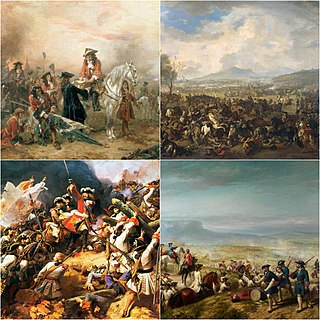
The War of the Spanish Succession was a European great power conflict fought between 1701 and 1714. The immediate cause was the death of the childless Charles II of Spain in November 1700, which led to a struggle for control of the Spanish Empire. His nominated heir was Philip of Anjou, a grandson of Louis XIV of France, whose main backers were France and most of Spain. His rival, Archduke Charles of Austria, was supported by the Grand Alliance, whose primary members included the Holy Roman Empire, the Dutch Republic, and Great Britain. Significant related conflicts include the 1700 to 1721 Great Northern War, and Queen Anne's War in North America.

The Battle of Almansa took place on 25 April 1707, during the War of the Spanish Succession. It was fought between an army loyal to Philip V of Spain, Bourbon claimant to the Spanish throne, and one supporting his Habsburg rival, Archduke Charles of Austria. The result was a decisive Bourbon victory that reclaimed most of eastern Spain for Philip.

The Battle of Denain was fought on 24 July 1712 as part of the War of the Spanish Succession. It resulted in a French victory, under Marshal Villars, against Dutch and Austrian forces, under Prince Eugene of Savoy.
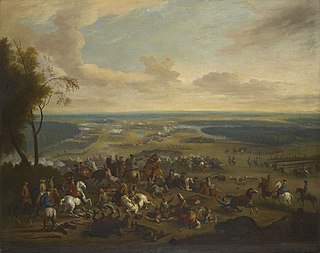
The Battle of Malplaquet took place on 11 September 1709 during the War of the Spanish Succession, near Taisnières-sur-Hon in modern France, then part of the Spanish Netherlands. A French army of around 75,000 men, commanded by the Duke of Villars, engaged a Grand Alliance force of 86,000 under the Duke of Marlborough. In one of the bloodiest battles of the 18th century, the Allies won a narrow victory, but suffered heavy casualties.
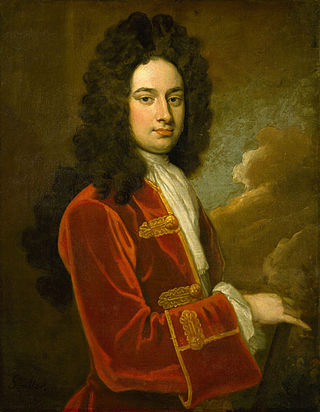
James Stanhope, 1st Earl Stanhope was a British Army officer, politician, diplomat and peer who effectively served as Chief Minister between 1717 and 1721. He was also the last Chancellor of the Exchequer to sit in the House of Lords.

The Battle of Oudenarde, also known as the Battle of Oudenaarde, was a major engagement of the War of the Spanish Succession, pitting a Grand Alliance force consisting of eighty thousand men under the command of the Duke of Marlborough and Prince Eugene of Savoy against a French force of eighty-five thousand men under the command of the Duc de Bourgogne and the Duc de Vendôme, the battle resulting in a great victory for the Grand Alliance. The battle was fought near the city of Oudenaarde, at the time part of the Spanish Netherlands, on 11 July 1708. With this victory, the Grand Alliance ensured the fall of various French territories, giving them a significant strategic and tactical advantage during this stage of the war. The battle was fought in the later years of the war, a conflict that had come about as a result of English, Dutch and Habsburg apprehension at the possibility of a Bourbon succeeding the deceased King of Spain, Charles II, and combining their two nations and empires into one.

The Battle of Guadalajara saw the victory of the Spanish Republican Army and of the International Brigades over the Italian and Nationalist forces attempting to encircle Madrid during the Spanish Civil War. The Nationalist forces involved in the Battle of Guadalajara were primarily the Italian Corps of Volunteer Troops.
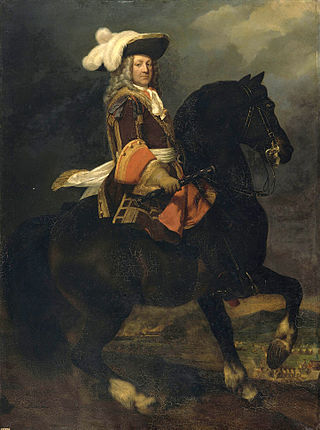
The Battle of Brihuega took place on 8 December 1710 in the War of the Spanish Succession, during the Allied retreat from Madrid to Barcelona. A British Army rearguard led by James Stanhope, 1st Earl Stanhope was cut off and trapped within the town of Brihuega before being overwhelmed by a Franco-Spanish army under the command of Louis Joseph, Duke of Vendôme. The battle, along with other events, brought an end to British participation in the war.

Guido Wald Rüdiger, Count of Starhemberg was an Austrian military officer (commander-in-chief) and by birth member of the House of Starhemberg.
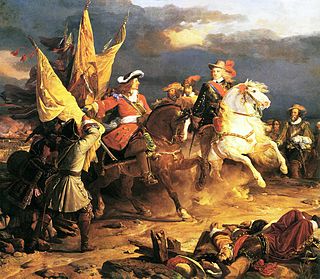
The Battle of Villaviciosa was a battle between a Franco-Spanish army led by Louis Joseph, Duke of Vendôme and Philip V of Spain and a Habsburg-allied army commanded by Austrian Guido Starhemberg. The battle took place during the War of the Spanish Succession, one day after a Franco-Spanish victory at Brihuega against a British army under James Stanhope, 1st Earl Stanhope. Both Philip V of Spain and the Archduke Charles of Austria claimed victory, but the number of dead and wounded, the number of artillery and other weapons abandoned by the Allied army and the battle's strategic consequences for the war confirmed victory for Philip.

The Battle of Almenar also referred to as Almenara was a battle in the Iberian theatre of the War of the Spanish Succession.
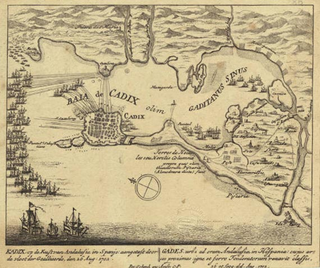
The Battle of Cádiz, fought in August/September 1702, was an Anglo-Dutch attempt to seize the southern Spanish port of Cádiz during the War of the Spanish Succession. The Andalusian city of Cádiz was the great European centre of the Spanish–American trade. The port's capture would not only help to sever Spain's links with her empire in the Americas, but it would also provide the Allies with a strategically important base from which the Anglo-Dutch fleets could control the western Mediterranean Sea.
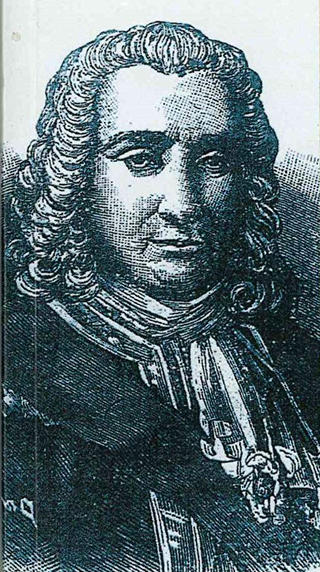
D. António Luís de Sousa, 4th Count of Prado and 2nd Marquess of Minas was a Portuguese general and governor-general of the Portuguese colony of Brazil.

Juan José Navarro y Búfalo, 1st Marquess of Victoria, OSJ was a Spanish military officer who served as first Captain general of the Navy from 1750 to 1772. A leading proponent of naval reform, he provided much of the practical curriculum for the Academia de Guardias Marinas, established in 1717 to provide professional training for Spanish marine officers.

The siege of Barcelona took place between 14 September and 19 October 1705 during the War of the Spanish Succession when a multinational Grand Alliance army led by Lord Peterborough, supporting the Habsburg pretender to the Spanish throne, captured the city of Barcelona from its Spanish Bourbonic defenders, most of whom then joined the Habsburg army.

General Sir Charles Wills was a British Army officer and politician who served as Lieutenant-General of the Ordnance sat as a member of parliament for Totnes from 1718 to 1741.
The Battle of La Gudiña, Battle of Val Gudina, or Battle of Campo Maior, was fought on 7 May 1709 near Arronches between the Spanish Bourbon army of Extremadura, under the Marquis de Bay, and the Portuguese and British, under the Huguenot Earl of Galway and the Marquis of Fronteira. This battle resulted in a crushing defeat for the Anglo-Portuguese army, 4,000-5,000 soldiers were killed, wounded or captured, while the Spanish had only 400 soldiers dead or wounded.

The twelfth siege of Gibraltar was fought between September 1704 and May 1705 during the War of the Spanish Succession. It followed the capture in August 1704 of the fortified town of Gibraltar, at the southern tip of Spain, by an Anglo–Dutch naval force led by Sir George Rooke and Prince George of Hesse-Darmstadt. The members of the Grand Alliance, the Holy Roman Empire, England, the Netherlands, Pro-Habsburg Spain, Portugal and Savoy, had allied to prevent the unification of the French and Spanish thrones by supporting the claim of the Habsburg pretender Archduke Charles VI of Austria as Charles III of Spain. They were opposed by the rival claimant, the Bourbon Philip, Duke of Anjou, ruling as Philip V of Spain, and his patron and ally, Louis XIV of France. The war began in northern Europe and was largely contained there until 1703, when Portugal joined the confederate powers. From then, English naval attentions were focused on mounting a campaign in the Mediterranean to distract the French navy and disrupt French and Bourbon Spanish shipping or capture a port for use as a naval base. The capture of Gibraltar was the outcome of that initial stage of the Mediterranean campaign.
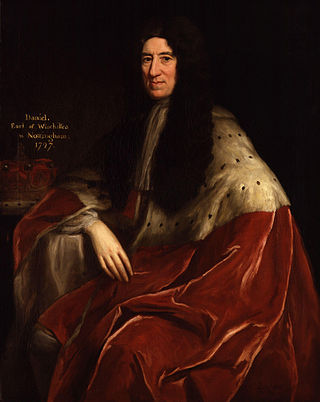
No Peace Without Spain was a popular British political slogan of the early eighteenth century. It referred to the ongoing War of the Spanish Succession (1701–1714) in which Britain was a leading participant. It implied that no peace treaty could be agreed with Britain's principal enemy Louis XIV of France that allowed Philip, the French candidate, to retain the Spanish crown. The term became a rallying cry for opposition to the Tory government of Robert Harley, Earl of Oxford and the terms of the Treaty of Utrecht.




















